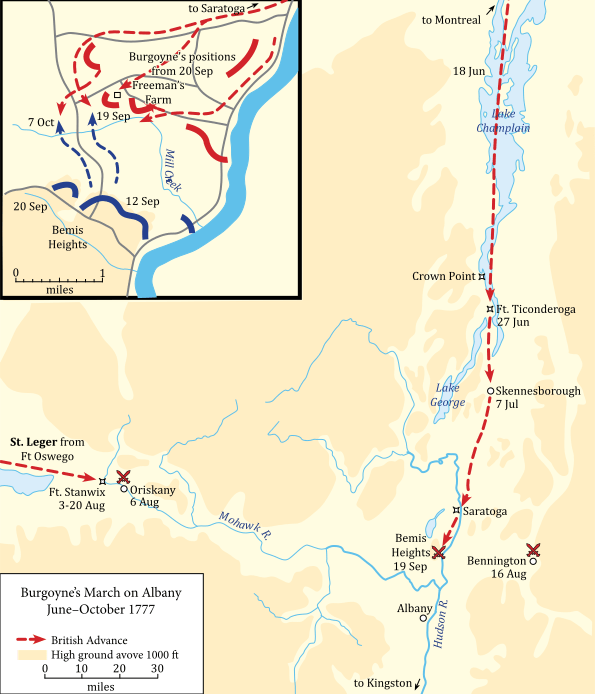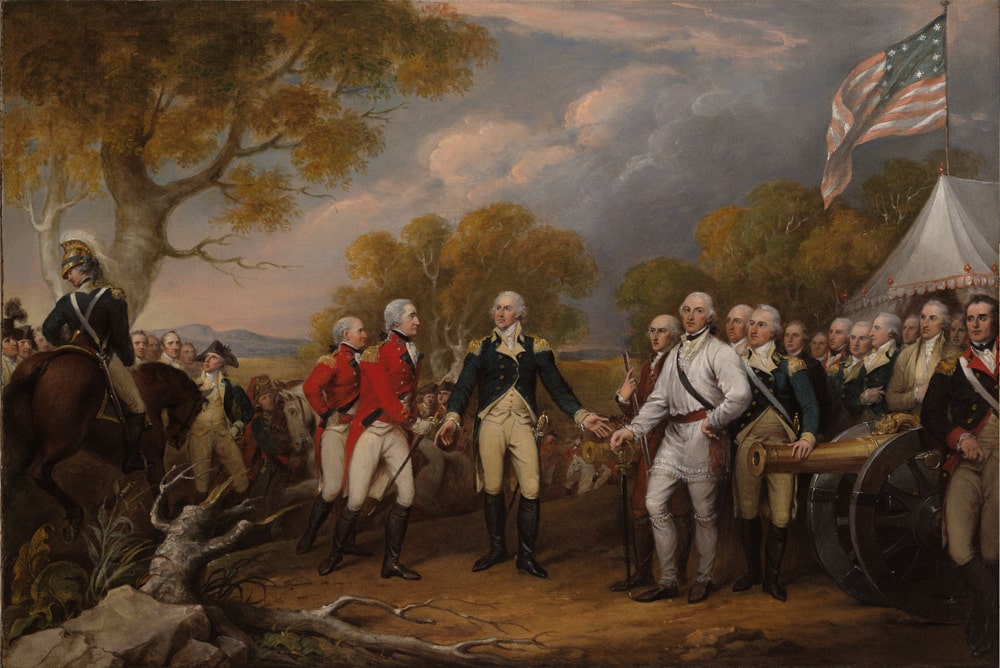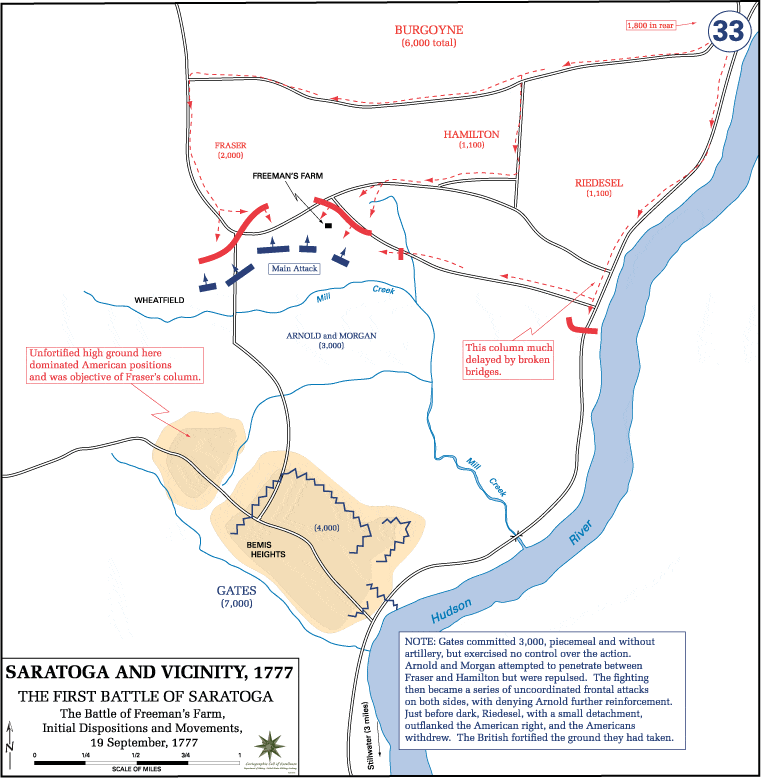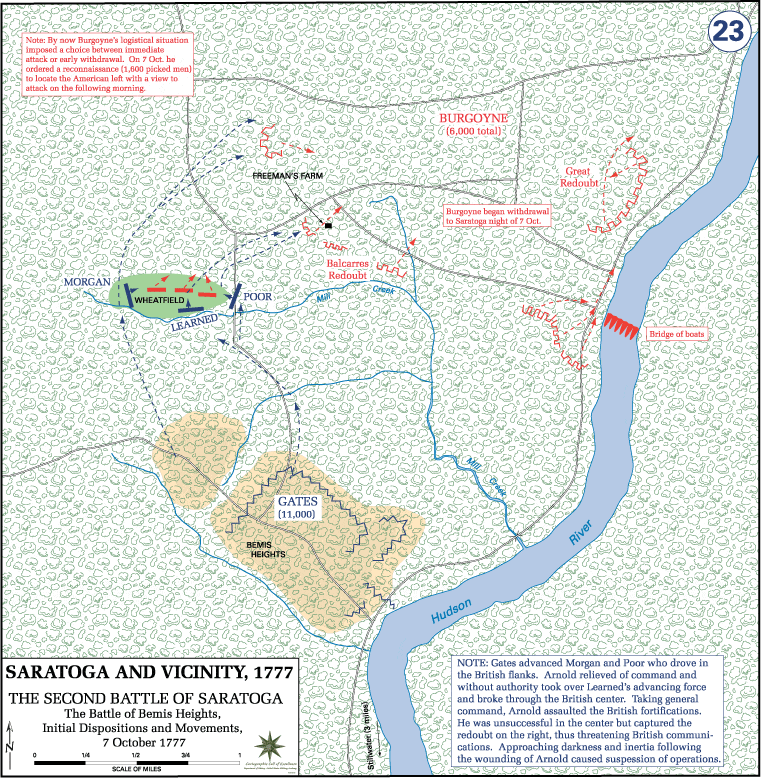Contents
Contents
The Battles of Saratoga were fought on September 19th and October 7th, 1777, between the British Army and the Continental Army near the village of Saratoga, New York.
Summary
Leadup
In 1777, British military command devised a new strategy to combat the Patriot movement: they would cut off the radical New England colonies from the more Loyalist middle and southern colonies.
The British thought that by cutting colonial territory in two, they could begin to surround and move in on Patriot strongholds in New England, while easily suppressing any resistance in the other colonies to the south.
To achieve this, the British sent forces in a pincer movement to cut off New England, approaching Albany from three directions during the Saratoga Campaign:
- 2,000 troops under the command of Barry St. Leger were sent south-west from Montreal, down the St. Lawrence River. They then proceeded east towards Albany, but were stopped by Patriot forces at the Siege of Fort Stanwix in August 1777.
- 13,000 troops under the command of General William Howe were planned to approach Albany by moving north up the Hudson River from New York City. However, Howe decided to launch an attack on Philadelphia instead in late August 1777, leading his troops in the opposite direction. He did this under the condition that his army would later help with the attack on Albany, but they were unable to assist.
- 8,000 troops, including 3,000 German auxiliaries, under the command of General John Burgoyne, moved south from St. Jean, Quebec, to attack Albany from the north. His troops arrived at Fort Ticonderoga, midway down Lake Champlain, in early July. American forces decided to retreat after learning that they were vastly outnumbered, allowing the British to capture the fort without firing a single round. As they moved further south, Burgoyne’s forces began to face issues with their supply lines, but he still had the majority of his 8,000 troops available for their first real encounter with colonial forces.

The first battle – September 19, 1777
Learning of the British advance, 8,500 troops under the command of General Horatio Gates were sent to intercept Burgoyne, along with General Benedict Arnold as a senior field commander.
As Commander-in-Chief of the Continental Army, George Washington was most concerned about the movement of General Howe’s large militia north up the Hudson River. Therefore, Washington also ordered an additional 750 men under the command of Israel Putnam to support Gates’ forces, as well as 500 highly skilled snipers from Morgan’s Riflemen.
Patriot forces set up defenses at Bemis Heights, constructing fortifications, and setting up artillery cover.
Meanwhile, Burgoyne’s army was struggling. A German detachment sent to capture supplies in Bennington, Vermont was almost completely destroyed, and as he marched south, Burgoyne also left behind a number of men to defend Fort Ticonderoga.
Despite these difficulties, Burgoyne decided to press on, believing he would be supported by Howe’s troops from the south.
On September 19, British and American forces clashed at Freeman’s Farm in Saratoga, in front of Bemis Heights.
The battle was fierce. Initially, the British suffered heavy losses at the hands of Daniel Morgan’s Riflemen, who were picking off British soldiers as they advanced through open ground.
However, British reinforcements soon arrived, at which point the battle became chaotic, and much more closely fought.
By nightfall, the British gained control of the battlefield, but suffered significant casualties – approximately 600 men, compared to 350 Americans killed and wounded.
Aftermath of the first battle
Burgoyne was in a difficult position.
His army was running low on food, but he still believed that reinforcements were coming. He initially considered an immediate attack on September 21, but decided to consolidate his position and wait for help instead.
While Howe had turned south towards Philadelphia, 3,000 men under the command of General Sir Henry Clinton were moving north along the Hudson River Valley, capturing Forts Montgomery and Clinton in early October.
Meanwhile, the Americans were constantly receiving reinforcements from nearby colonies.
They had no such supply issues, and during the interlude between the two battles, managed to add approximately 3,000 troops to their forces.
However, in the American camp, General Arnold and Gates were in constant disagreement.
Arnold wanted to pursue a more aggressive strategy, while Gates, who was in command, refused.
Gates minimized Arnold’s contributions during the first battle in his communications with military leaders, and eventually removed Arnold from his command.
In between the two battles, minor skirmishes continued to occur, with Morgan’s Riflemen causing a particular headache for British patrols.
The second battle – October 7, 1777
On October 7, Burgoyne accepted that help was not going to arrive, and with about 6,500 troops remaining, launched an attack on the American position.
The British were quickly pushed back, losing General Simon Fraser in an attack on the left side of the American fortifications.
On October 8, the British began retreating, and Arnold defied orders, commanding his forces on horseback in the field. Soon, the Continental Army completely surrounded the remaining British troops at Saratoga on October 17, forcing their surrender.
By the end of the battle, the Patriot forces numbered 15,000 men. By contrast, about 6,000 British soldiers surrendered to the American forces.
Significance

The Battles of Saratoga turned the tide of the Revolutionary War in favor of the Americans.
The result was the most comprehensive victory that either side had achieved up to this point in the war, and it was a significant boost for colonial morale.
The coordination and resolve shown by the Continental Army, and the fact that so many men were willing to join their ranks during the battle, was also a significant hit to British confidence. Losing 6,000 troops was also a massive psychological blow to the Loyalists.
Though they had been unofficially supporting the Patriot cause up to this point, the Battles of Saratoga further demonstrated to the French that the Americans had a strong chance of defeating the British Army.
Therefore, as a result of American victory at Saratoga, the French decided to officially enter the war on the Patriot side, with the two sides signing the Franco-American alliance on February 6, 1778.
The addition of French help was a significant boost to the Continental Army. It solved supply problems, allowed them to put up a much stronger fight against the British Navy, thanks to the assistance of French ships, and also helped them bolster their troops on the ground.
Facts
- Benedict Arnold received a severe leg injury as a result of his antics in the field at the second Battle of Saratoga, leaving him unable to walk for nearly six months.
- General Gates later led a plot against George Washington for leadership of the Continental Army, but was unsuccessful, instead being placed in command of the southern forces.
- Burgoyne and his men were supposed to be allowed to return to England after being captured, under the condition that they did not fight in America again. However, Congress did not trust the British to uphold their end of the agreement that Burgoyne had signed, and so the troops remained in America as de facto prisoners of war. Known as the Convention Army, named after the Convention of Saratoga signed after the surrender, they were housed in poor conditions in Massachusetts and Virginia. Burgoyne himself was allowed to return home, but the Convention Army remained in North America until 1783.
- On his march south, Burgoyne opted to travel with 30 wagons of his own luggage, including fine silverware, wine, and a mistress, despite having to move through difficult terrain and wilderness.
- General Clinton never made it to Saratoga. His troops only advanced partway up the Hudson before turning back.



